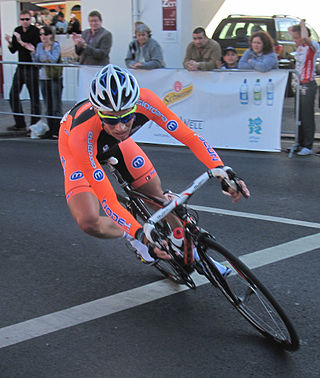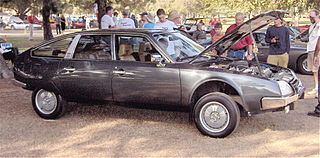
A shock absorber or damper is a mechanical or hydraulic device designed to absorb and damp shock impulses. It does this by converting the kinetic energy of the shock into another form of energy which is then dissipated. Most shock absorbers are a form of dashpot.

Steering is the control of the direction of motion or the components that enable its control. Steering is achieved through various arrangements, among them ailerons for airplanes, rudders for boats, tilting rotors for helicopters, and many more.

The Citroën DS is a front mid-engined, front-wheel drive executive car manufactured and marketed by Citroën from 1955 to 1975, in fastback/sedan, wagon/estate, and convertible body configurations, across three series of one generation.

Electronic stability control (ESC), also referred to as electronic stability program (ESP) or dynamic stability control (DSC), is a computerized technology that improves a vehicle's stability by detecting and reducing loss of traction (skidding). When ESC detects loss of steering control, it automatically applies the brakes to help steer the vehicle where the driver intends to go. Braking is automatically applied to wheels individually, such as the outer front wheel to counter oversteer, or the inner rear wheel to counter understeer. Some ESC systems also reduce engine power until control is regained. ESC does not improve a vehicle's cornering performance; instead, it helps reduce the chance of the driver losing control of the vehicle.

Suspension is the system of tires, tire air, springs, shock absorbers and linkages that connects a vehicle to its wheels and allows relative motion between the two. Suspension systems must support both road holding/handling and ride quality, which are at odds with each other. The tuning of suspensions involves finding the right compromise. It is important for the suspension to keep the road wheel in contact with the road surface as much as possible, because all the road or ground forces acting on the vehicle do so through the contact patches of the tires. The suspension also protects the vehicle itself and any cargo or luggage from damage and wear. The design of front and rear suspension of a car may be different.

A four-wheel drive, also called 4×4 or 4WD, is a two-axled vehicle drivetrain capable of providing torque to all of its wheels simultaneously. It may be full-time or on-demand, and is typically linked via a transfer case providing an additional output drive shaft and, in many instances, additional gear ranges.

Hydropneumatic suspension is a type of motor vehicle suspension system, designed by Paul Magès, invented by Citroën, and fitted to Citroën cars, as well as being used under licence by other car manufacturers. Similar systems are also widely used on modern tanks and other large military vehicles. The suspension was referred to as Suspension oléopneumatique in early literature, pointing to oil and air as its main components.

The Citroën C5 is a large family car produced by the French manufacturer Citroën since March 2001, currently at its third generation. It replaced the Citroën Xantia, in the large family car class, and is the first modern Citroën with "Cx" naming nomenclature, previously used by its ancestors, the C4 and C6 from 1930. A crossover, unrelated to the previous generations, was released in 2021, with crossover styling and marketed as the Citroën C5 X.

The Citroën XM is a front-engine, front-drive, five-passenger, five-door hatchback noted for its hydropneumatic suspension. Manufactured and marketed by Citroën from 1989 to 2000, with a minor facelift in 1994, XM production reached 333,405 over the course of 11 years.

The Citroën Xantia, pronounced "Zan–ti–a" is a large family car (D) produced by the French automaker Citroën, and designed by Bertone. Presented to the press in December 1992, the car was produced between 1992 and 2001 in France, with a facelift in the end of 1997.

An anti-roll bar is an automobile suspension part that helps reduce the body roll of a vehicle during fast cornering or over road irregularities. It links opposite front or rear wheels to a torsion spring using short lever arms for anchors. This increases the suspension's roll stiffness—its resistance to roll in turns.
Power steering is a system for reducing a driver's effort to turn a steering wheel of a motor vehicle, by using a power source to assist steering.

Active Body Control, or ABC, is the Mercedes-Benz brand name used to describe electronically controlled hydropneumatic suspension.
Air suspension is a type of vehicle suspension powered by an electric or engine-driven air pump or compressor. This compressor pumps the air into a flexible bellows, usually made from textile-reinforced rubber. Unlike hydropneumatic suspension, which offers many similar features, air suspension does not use pressurized liquid, but pressurized air. The air pressure inflates the bellows, and raises the chassis from the axle.
Self-levelling refers to an automobile suspension system that maintains a constant ride height of the vehicle above the road, regardless of load.

Height adjustable suspension is a feature of certain automobile suspension systems that allow the motorist to vary the ride height or ground clearance. This can be done for various reasons including giving better ground clearance over rough terrain, a lower ground clearance to improve performance and fuel economy at high speed, or for stylistic reasons. Such a feature requires fairly sophisticated engineering.
A magnetorheological damper or magnetorheological shock absorber is a damper filled with magnetorheological fluid, which is controlled by a magnetic field, usually using an electromagnet. This allows the damping characteristics of the shock absorber to be continuously controlled by varying the power of the electromagnet. Fluid viscosity increases within the damper as electromagnet intensity increases. This type of shock absorber has several applications, most notably in semi-active vehicle suspensions which may adapt to road conditions, as they are monitored through sensors in the vehicle, and in prosthetic limbs.
A regenerative shock absorber is a type of shock absorber that converts parasitic intermittent linear motion and vibration into useful energy, such as electricity. Conventional shock absorbers simply dissipate this energy as heat.
TEMS is a shock absorber that is electronically controlled based on multiple factors, and was built and exclusively used by Toyota for selected products during the 1980s and 1990s. The semi-active suspension system was widely used on luxury and top sport trim packages on most of Toyota's products sold internationally. Its popularity fell after the “bubble economy” as it was seen as an unnecessary expense to purchase and maintain, and remained in use on luxury or high performance sports cars.















